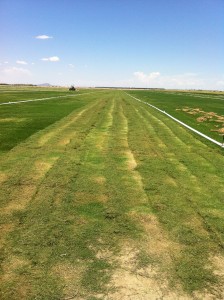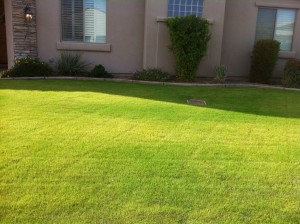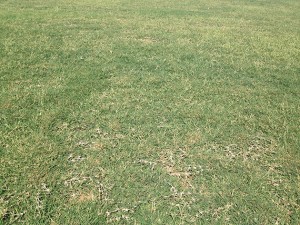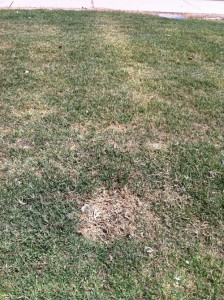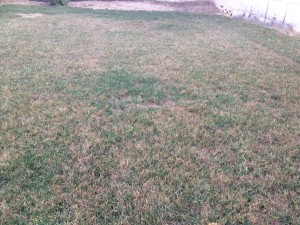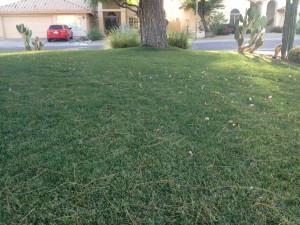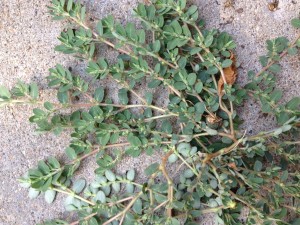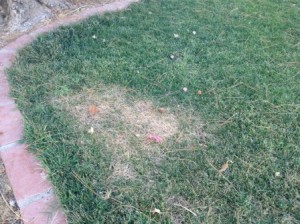Jun
Summer Grass Problems & EASY Grass Solutions!
I thought it would be nice to put up some pictures of common summer issues–and some easy solutions. While there are several areas I could expand, I’ll leave it to the most common areas of concern for now……
During the summer months you will see scalping in turf for a variety of reasons but some of the most common are:
1. Lawn is too lush or juiced up on fertilizer
2. The lawn is too thick and it needs to be verticut to remove dead material between grass blades.
3. The mower blades are too dull or the wheels of the mower are set to uneven heights. The picture above represents this very well.
A yellow lawn can be caused by a lack of nutrients but the most likely candidates are nitrogen and iron. During the summer months bermudagrass can utilize 1-2 pounds of nitrogen per 1000 SF per growing month. I suggest alternating applications between slow and fast release fertilizers.
In this picture you can see the stolons (aka runners) looking for a place to tack down into the ground. Since there is no available area they have a tendency to sit on top of the turf. A light verticut will open up the soil and allow for these runners to take hold.
Often times you will see areas come out of the spring transition that don’t fully recover. There is nothing to worry about because this can easily be fixed. The picture above represents a couple of issues including lack of water and dead spots. Running a verticutter over the lawn will open up the turf canopy and allow sunlight and water to get into the plant. Anytime there is dead material on the surface it doesn’t give this grass an opportunity for new growth. The watering simply needs to be increased to keep up with the daily demand of the hot weather.
You can notice all of the dead ryegrass between the leaf blades of this grass. This material does not allow the grass the grow and fill in the gaps. Running the verticut or dethatcher over the lawn will remove all of this extra material and give the runners a place to move.
I have attached an old verticutting video I shot a few years back. Unfortunately you will see me suggest the Soil Burst 7-7-7 at the end of the video but we no longer carry the product. You can use either the Soil Burst 5-15-10, 21-7-14, or 21-0-0 to give your lawn a boost after verticutting. CLICK HERE FOR THE VIDEO.
This is a picture of the ryegrass currently under my pine tree in my yard. Yes the grass looks perfect now and is doing well holding up to the heat; the humidity is right around the corner. For those of you that have ryegrass sticking around under your trees you have the option of trying to spray a fungicide and keep the grass longer to maintain vigor or watch it quickly die once we get humid. Putting down a fungicide does not guarantee it will grow or stay alive, it will merely help ward off any pathogens that might attack the grass. The heat/humidity is still going to be a serious issue for a cool season grass during the hot summer months. I can typically keep my grass through mid-July but it rarely lasts longer than that. Since this area gets very little sun I do have to patch the bermudagrass every couple years but I will do that in order to not look at dirt.
Most of us will see spurge start to grow from the ground in late spring and at times we will see some invade turf areas. This is very easy to treat with a chemical that contains 2,4-D, and Dicamba. This is readily available at most retailers and also at irrigation specialty stores. I advise spraying weeds early in the morning when temperatures are below 85 degrees.
Before I tell you what is going on in this picture take a walk outside and see if you have any similar spots. Any idea what is causing it? Most of us use pop up type sprinkler heads and even though the sprinkler is located right behind this spot it is not covering this area. How can that be? The sprinkler pops up 3″ and the spray often starts 12-15″ in front of the sprinkler leaving a spot with no water. If you get sprinkler to sprinkler coverage this will not be an issue but if your heads spray short you likely have spots like this at home. One easy way to fix this is to buy dual nozzles. They have two spray patterns that come out of the nozzles. One shoots straight out and the other shoots down to cover the full area. If you can’t find any of these nozzles you can always buy larger nozzles for your other sprinklers so they cover head to head.
Hopefully these pictures are helpful and if you have other questions I’m happy to answer them for you. Just hit the “Ask Jay” button on the top right of this page. When you submit a question it helps if you can tell me your grass variety, how often and long you water, fertilizer schedule and type and where you live.
Until next time,
Jay

